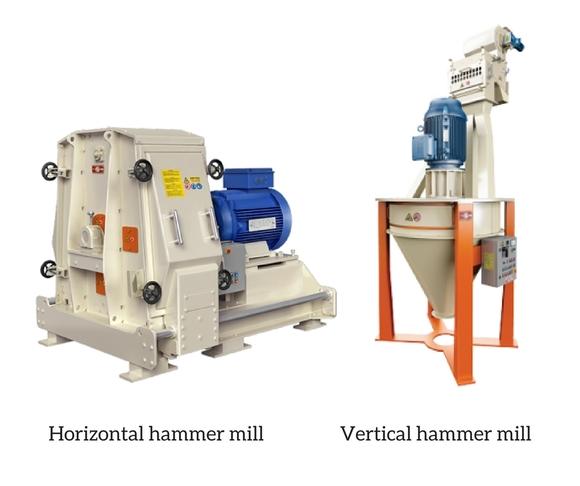Horizontal vs Vertical Hammer mill
Grinding is accomplished by many types of manual and mechanical operations involving impact, attrition and cutting. a) Hammer mills: are mostly impact grinders with swinging or stationary steel bars forcing ingredients against a circular screen or solid serrated section designated as a striking plate. The material is held in the grinding chamber until it's reduced to the size of the openings in the screen. The number of hammers on a rotating shaft, their size, arrangement or sharpness, the speed of rotation, the wear patterns and the clearance at the tip relative to the screen or striking plate are important variables in grinding capacity and the appearance of the product. Heat imparted to the material, due to the work of grinding, is related to the time it is held within the chamber and the air flow characteristics. Impact grinding is most efficient with dry, low-fat ingredients, although many other materials may be reduced in size by proper screen selection and regulated intake. Two types of arrangements exists in the hammer mill: Horizontal hammer mill: it’s the most common and consists of an horizontal drive shaft, which suspends vertical hammers to crush any friable and fibrous dry materials containing less fat. Vertical hammer mill: in this mill, the drive shaft is positioned vertically and screens and hammers are positioned horizontally. Material successfully reduced in size to the diameter of screen holes or smaller, are carried by gravity outside the mill and thence by air or conveyor to storage in "make-up" bins. Oversize particles, not easily broken, drop through the mill and may be recycled or discarded. Thus, foreign materials, such as metal and stones, are discharged before they are forced through the screen causing damage. b ) Disk Mills: they use the shattering by impact, but also impart a shearing and cutting action. Grinding is done between two discs equipped with replaceable wearing surfaces. One or both discs rotate; if both, they rotate in opposite directions. When one disc rotates and the other is stationary, the assembly is used for shredding and deferring. Often materials which have been coarsely ground by other mills, are passed through an attrition mill for blending or smoothing out an ingredient or mixture containing liquids which may have clumps. The discs of an attrition mill are generally in a vertical position so that materials not capable of reduction can pass by gravity out of the grinding area. c) Roller Mills: in this case occurs a combination of cutting, attrition, and crushing. There are smooth or corrugated rolls rotating at the same speed set at a predetermined distance apart with material passing between the two. A tearing action may be added by operating the rolls at different speeds and by corrugations which are different for each roll (for example, the top roll may have off-radial spiral corrugations and the bottom roll lateral corrugations). Roll grinding is economical but limited to materials which are fairly dry and low in fat.










